|
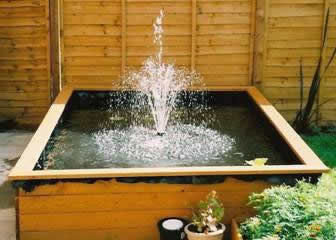
A newly constructed pond (sunken and raised combination), prior to tidying up the liner and adding finishing touches
The possible design opportunities for a garden pond are limitless.
However, no matter what sort of pond you decide to create, these are some of the factors that should be taken into account at the planning stage.
Location
A pond is going to be a long-term feature of your garden, so taking some time at this stage is well worth it.
It won’t always be possible to find the ideal spot without any compromises, but at least if you’re aware of the potential issues you can plan for them.
Aesthetics
It sounds obvious but choose a location where you will be able to enjoy your new pond.
There is little point in tucking it into an unused corner of the garden where you will hardly ever visit it.
Close to a favourite garden seating area is a good idea. You can sit and admire your hard work at the end of a long day whilst listening to the sound of running water.
Areas close to the house also work well. If you can see your pond from a window you will be able to enjoy it all year round whatever the weather.
Trees
The ideal location will be well away from any overhanging or potentially large trees. Leaf-fall from deciduous trees can cause pollution within the pond and roots from large trees are potentially damaging to pond liners.
Although netting the pond during Autumn and manually removing dead leaves is a possibility, it greatly increases the amount of maintenance required.
If an area near to tree roots is the only option, the problems can be minimised by opting for a raised pond or by using a rigid pre-formed pond.
Light
The perfect spot would receive direct sunlight for just a few hours a day. Much more than this and you will be prone to algae problems during the Summer. No sunlight and you may have problems getting plants to grow.
Pond planting is, of course, not compulsory and almost impossible if you want to stock Koi.
In locations with a lot of direct sunlight algae issues can be minimised by using floating plant coverage and Water Lilies.
Gradient
It’s stating the obvious, but your pond needs to be level.
Achieving this is far easier if you have a level stretch of garden to begin with. However by going for a partially raised design, ponds can be incorporated into sloping landscapes.
Care must be taken, however, to minimise run-off of water from the garden above.
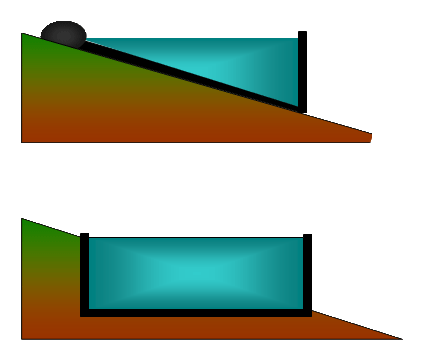
Raised, Sunken or Combination ?
Whatever sort of pond you want, there are three broad design strategies to choose from.
Each has its own advantages / disadvantages and your choice may be dictated to some extent by the choice of location.
The Raised Pond
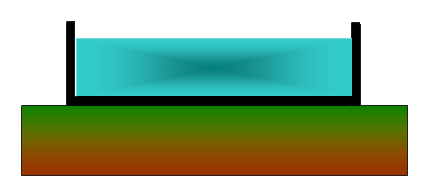
Raised ponds are normally geometric in shape. This design looks best in more formal areas of the garden, for example, incorporated into a patio or decking area close to the house.
The sides of the pond can be constructed of either timber or brickwork to fit in with the setting.
Advantages
- They are safer than submerged ponds for families with young children or pets.
- No heavy, deep digging is required.
- They bring the water closer to the level of the pond-keeper making maintenance and viewing easier.
Disadvantages
- Slightly more advanced DIY skills may be required for this type of pond. Particular attention is needed to the sides of the pond. These must be strong and sturdy enough to withstand the pressure of the water.
- If you are planning on keeping fish you need a depth of at least 2’ in order to avoid freezing or overheating – this may lead to an extremely large construction project and additional strain on the sides of the pond.
The Sunken Pond
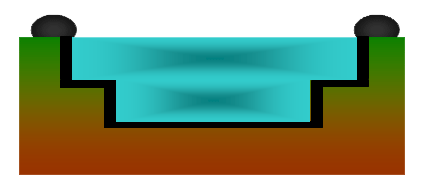
Sunken ponds are far more flexible in terms of size and shape. They work equally well as a natural looking wildlife pond or built in a geometric shape as part of a more formal setting.
Advantages
- There are no restrictions on depth or shape.
- The sides of the pond are supported by earth, so there is no worry about the pressure of the water.
- They are accessible to wildlife.
Disadvantages
- A lot of heavy digging and earth removal is required.
- They are only suitable for completely level sites in the garden.
- If you are planning on keeping fish, this style of pond is also more accessible to predators.
The Combination / Semi-raised Pond

Ponds that are built partly above and partly below the surface bring together the best of both types of design.
Advantages
- They incorporate the safety features of a raised pond, but the required depth is gained by digging down, rather than building up. This makes the construction a lot simpler and reduces the strain on the free-standing sides.
- This type of design can be used to “cut” a pond into a sloped garden.
- There is considerably less digging involved than when creating a completely sunken pond.
Disadvantages
- This style of pond is still best suited to geometric shapes, lending it a formal look which may not blend well in all gardens.
- The raised sides keep it inaccessible to many small animals, making it a poor choice for a wildlife pond.
Stepped, Sloped or Vertical ?
Once you’ve decided on the basic design, the next step is to decide on how to construct the sides of the pond. Again there are 3 broad options.
Stepped Ponds
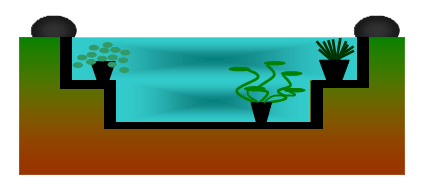
The idea behind the stepped pond is to create a series of shelves down to the bottom of the pond.
The main advantage of this is that it enables you to arrange a wide variety of plants at varying levels within the pond. You can accommodate the whole range from marginals to deep-water species.
There is less excavation required than for a single depth pond and any small animals that fall into the pond have a better chance of escape.
A stepped effect is particularly suited to sunken and semi-raised ponds, but a fully raised pond can also be stepped by using a series of blocks or back-filling with earth.
Sloped Ponds
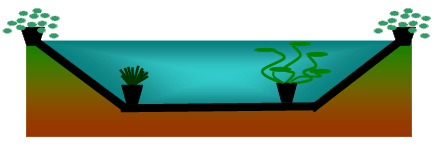
This is the typical wildlife pond design.
The sloping sides give easy access and exit to wildlife, however planting is restricted to the edges and flat base of the pond.
Although possible, this design would rarely be used for raised or semi-raised ponds.
Vertically sided ponds

This style of pond is dedicated to the fish, rather than wildlife or planting.
The smooth vertical walls give the maximum volume of water for the amount of space utilised by the pond.
Planting is limited to floating plants or deep-water species, however this design is typical of a Koi pond where planting is not a realistic option.
For safety reasons this is best restricted to raised or semi-raised designs.
|







